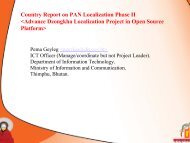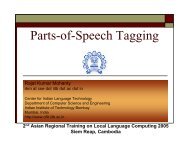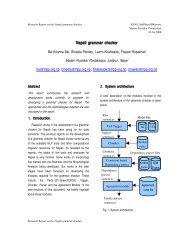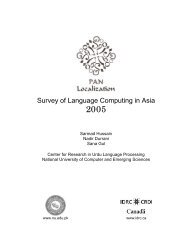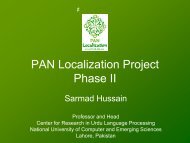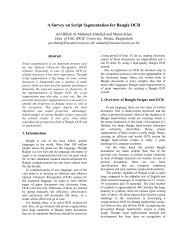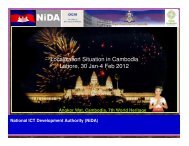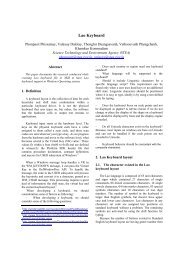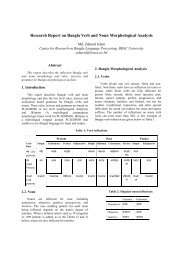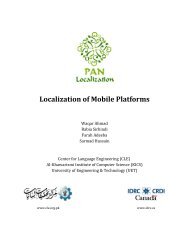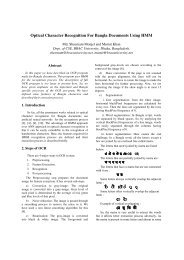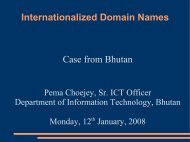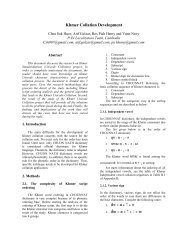Urdu Domain Names - PAN Localization
Urdu Domain Names - PAN Localization
Urdu Domain Names - PAN Localization
You also want an ePaper? Increase the reach of your titles
YUMPU automatically turns print PDFs into web optimized ePapers that Google loves.
B. Punycode<br />
In order to make the hostname DNS compatible the<br />
Unicode string has to be converted to ACE. Many schemes<br />
have been proposed in this regard. Punycode is a bootstring<br />
encoding mechanism that uniquely converts Unicode<br />
string to the allowed ASCII based encoding. This<br />
conversion takes place through an algorithm known as<br />
ToASCII(). ToUnicode() converts back ASCII based<br />
encoding into Unicode compatible scheme. Punycode uses<br />
conventional ASCII i.e. a-z, 0-9 and hyphen, for backward<br />
compatibility [6].<br />
The ToASCII function is applied separately to all the<br />
labels in domain name. There is a possibility that the<br />
generated Punycode is already a registered domain. For<br />
example, when http://www.ا.com is converted using<br />
ToASCII() function, the domain name ا (U+0627) is<br />
converted to ASCII string “mgb” but http://www.mgb.com<br />
may already be a registered domain. To avoid significant<br />
duplication, all such conversions through the ToASCII()<br />
function are appended with a four character prefix “xn--”.<br />
The URL http://www.ا.com is therefore converted into<br />
http://www.xn--mgb.com.<br />
III. EVALUATION OF DNS AND IDNA<br />
Apart from political issues, there are also some<br />
additional criticism associated with DNS system generally<br />
and specifically for IDNA.<br />
Limitation of DNS to encode many languages due to its<br />
ASCII base has already been discussed.<br />
RFC 920 [9] expanded the addressing convention to<br />
include top level domains (TLDs) like .edu, .com, .org, etc.<br />
However, now these are being used beyond the intended<br />
usage. For example, .com.la was sold by Lao PDR to a<br />
group which is using this TLD for Los Angeles city, and<br />
Tuvalu’s county code .tv is being used by names associated<br />
with television.<br />
It is currently being debated whether IDN should ride<br />
over the existing DNS system, as discussed. ICANN argues<br />
for the importance of a single root. However, there are also<br />
other parallel namespaces which are successfully working,<br />
e.g. for companies like AOL and Skype, and for countries<br />
like China Internet Network Information Center (CNNIC),<br />
Japan Network Information Center (JPNIC) and Korea<br />
Network Information Center (KRNIC), which are<br />
maintaining thousands of addresses. And other domains<br />
like telephone exchanges have shown that parallel systems<br />
can co-exist and effectively communicate with proper<br />
collaboration [3].<br />
Though a unique Internet Protocol (IP) number<br />
identifies each address, DNS was introduced for the ease of<br />
users. However, DNS is not always visually unique, which<br />
can cause malicious or unintentional intervention. For<br />
example, lower case “L” in English looks similar to the<br />
upper case “I” or the digit “1” in some fonts. Thus, the<br />
website www.paypal.com may be written in different ways<br />
which are visually identical. Same is the case with the digit<br />
“0” and the upper case letter “O”. This confusion could be<br />
even more profound if additional scripts are incorporated in<br />
the URL to enable multilingual IDN and more phishing [10]<br />
attacks are possible [3].<br />
A variety of solutions have been considered to control<br />
the confusion that is caused by the visual similarity within a<br />
script, and enhanced by allowing multilingual domain<br />
names. At least one way to restrict some confusion is to<br />
disallow use of characters from different script blocks in<br />
Unicode to be used within a domain name. Thus, purely<br />
Arabic script domain names may be allowed but domain<br />
names with Arabic letters mixed with Latin characters may<br />
not be allowed. However, some languages do traditionally<br />
use some letters across scripts (as encoded in Unicode) and<br />
therefore some mechanism still needs to allow non-arbitrary<br />
and pre-defined mix of characters for certain languages.<br />
For example, <strong>Urdu</strong> may use digits in Latin block.<br />
Moreover, there may be confusion for a language<br />
within a script block. Unicode being a script based standard<br />
groups all letters across all languages which use the same<br />
script. There also additional variants due to other reasons 2 .<br />
Thus, from a single language there may be redundancy. So<br />
beyond normalization [normalization], which is not<br />
language specific, further language dependent mapping may<br />
also be required.<br />
Thus, language specific conventions need to be given<br />
for controlling which characters may be allowed within and<br />
across scripts for a particular language. This may also<br />
depend on where the language is used (for example, same<br />
language may be written using a different script in different<br />
regions). So the language specific information also needs to<br />
specify the region for which the conventions are valid. This<br />
may be achieved through defining language tables [17].<br />
There tables are to be maintained by the registrars of<br />
domains. The table for each language would list the “base<br />
characters” it allows and their “variant(s).” In addition, it<br />
would also contain letters from other scripts conventionally<br />
used by the language. The language table is labeled with<br />
language and regional codes, e.g. those used in locale<br />
definitions [2]. See [16] for a template for defining a<br />
language table.<br />
Finally, even though Punycode gives a unique<br />
mechanism for conversion between ASCII and Unicode, it<br />
is still being debated if this conversion will only be<br />
applicable the unique address or also to gTLDs and<br />
ccTLDs. This has significant political implications as well.<br />
IV. URDU DOMAIN NAMES<br />
Enabling domain names in <strong>Urdu</strong> also has significant<br />
political, social and financial implications. The rest of this<br />
paper discusses the technical challenges related to enabling<br />
<strong>Urdu</strong> IDN and proposes a solution. This solution has also<br />
been implemented as a concept system for testing and<br />
further improvement.<br />
2 For example, for backward compatibility.



